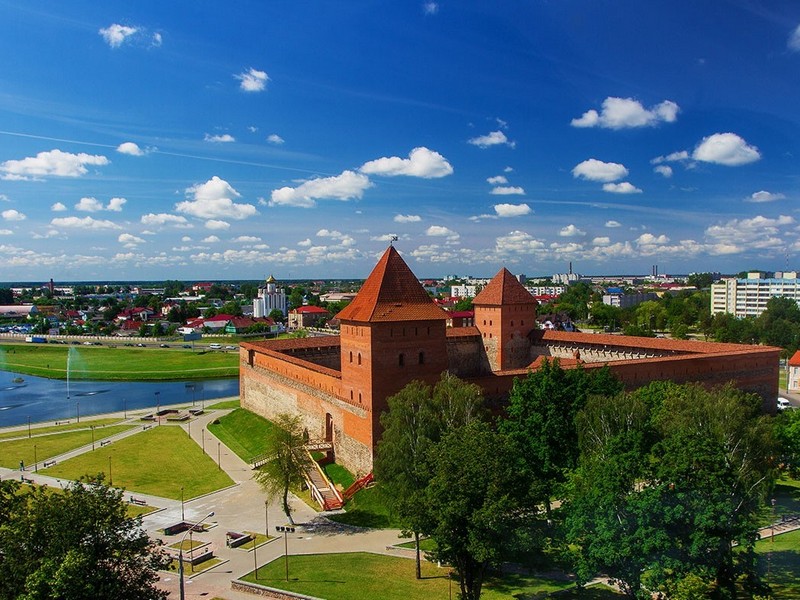Lida is a city in western Belarus in Hrodna Voblast, situated 160 kilometres (99 miles) west of Minsk. Founded in 1323. Population (2015) 99 976.
There are passing mentions of Lida in chronicles from 1180. Until the early 14th century the settlement at Lida was a wooden fortress in Lithuania proper. In 1323, the Grand Duke of Lithuania Gediminas built a brick fortress there. 1380 is generally considered the founding year of the city of Lida. The fortress withstood Crusader attacks from Prussia in 1392 and 1394 but it was burned to the ground in 1710. Following the death of Gediminas, when Lithuania was divided into principalities, Lida became the capital of one of them, the seat of Algirdas. During World War I Lida was occupied by the German troops. In 1919 the Red Army established Soviet power. Polish troops under General Józef Adam Lasocki reached the outskirts of Lida in early March 1919. On April 15 they resumed their advance and on April 17 they captured Lida, as a screening operation to the taking of Vilnius.On July 17, 1920, the Red Army returned but was forced to retreat in August following the Soviet defeat at Warsaw.
On September 30, 1920, Poland and Soviet troops fought in and near Lida during the battle of Niemen, as the Soviet 21st Rifle Division tried to assault Polish positions but was repulsed by the 1st Lithuanian-Belarusian Division; Poles took about 10,000 prisoners from the Soviet 3rd Army. After the 1920 Moscow Treaty it was ceded by the Soviets to Lithuania, this treaty however was not recognized by Poland. In accordance with Riga Peace Treaty of 1921, the town was awarded to Poland as the powiat centre in Nowogródek Voivodeship. In 1927, there were twenty-four factories in Lida, and production grew rapidly through 1928. A new rubber goods factory started up, employing almost 800 people. Lida was also an important garrison of the Polish Army, with one infantry division and the 5th Corps of the Polish Air Force stationed there. In 1939, following the Soviet invasion of Poland, Lida became part of the Byelorussian Soviet Socialist Republic. Beginning January 1940 Lida was the centre of Lida Raion, Baranavichy Voblast.
From June 1941 to July 1944, it was occupied by the German troops who killed almost 25,149 people. On September 18, 1943, the Jewish Community of Lida was rounded up and taken to Majdanek, where they were murdered. A small number of about 200 Lida Jews survived the Holocaust. Beginning of September 1944, Lida was in Grodno Region. During the Cold War and up until 1993 Lida was home to the 1st Guards Bomber Aviation Division of the Soviet Air Force.
Lida Castle was built by the order of The Grand Duke of Lithuania Gediminas for protection against the Teutonic Knights' assaults. The stone foundations of the castle were laid in 1323.[6] Parts of the trapezium-shaped fortress were added on up through the 15th century. In the mid-17th century, an army of 30,000 sent by Prince Nikita Khovansky of Moscow to destroy it, and in the Great Northern War (1700–1721), Swedes came and blew up the castle's towers, therefore permanently diminishing its military purpose. It has since been restored and tourists come to view its crimson walls.
The Roman Catholic Church of the Exaltation of the Cross, a fine example of local late Baroque architecture.
The Church of St. Joseph in Lida was built in 1794–1825. Built in the Late Classicism Style, the round stone church has an attractive dome and front. In 1842 it was destroyed by a fire, but was soon rebuilt. Currently it is an Orthodox Church.
The Catholic Church in Lida was given a new sanctuary in April 2007. The refreshingly white interior complements the tan exterior.
Starting from the spring of 2001, the Jewish Community of Belarus worked closely with the residents of Lida to erect a memorial commemorating the thousands of Lida Jews that perished in the Holocaust. In Autumn of 2003, an unveiling ceremony which involved 400 occurred. Now, visitors and residents alike can take a visit to this memorial, which properly honors all of those innocent victims of World War II.
- Show all
Крестовоздвиженский фарный костел — памятник архитектуры позднего барокко, который находится в Лиде.

Крестовоздвиженский фарный костел — памятник архитектуры позднего барокко, который находится в Лиде.
Лидская крепость (Лидский замок) для защиты восточных рубежей тогдашнего Литовского княжества

Лидская крепость (Лидский замок) для защиты восточных рубежей тогдашнего Литовского княжества









